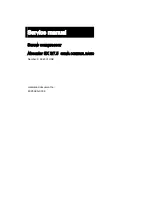
S
ECTION
6 - T
ECHNICAL
A
SSISTANCE
PAGE 6 - 4
5.
Check for excessive ring groove wear in pistons.
Every 6 Years or 48,000 Hours (plus Daily/Monthly/6 Months/1/2/4 Years
1.
Replace main and connecting rod bearing shells and bushings.
2.
Replace lubricator distribution blocks.
3.
Replace crosshead bushings.
4.
Replace DNFT.
Trouble Shooting
Minor problems can be expected during the routine operation of an Ariel compressor. These
troubles are most often traced to liquid, dirt, improper adjustment or to operating personnel
being unfamiliar with Ariel compressors. Difficulties of this type can usually be corrected by
cleaning, proper adjustment, elimination of an adverse condition, replacement of a relatively
minor part or proper training of the operating personnel.
Major problems can usually be traced to long periods of operation with unsuitable lubrica-
tion, careless operation, lack of routine maintenance or the use of the compressor for pur-
poses for which it was not intended.
Recording of the interstage pressures and temperatures on multistage units is valuable
because any variation, when operating at a given load point, indicates trouble in one of the
stages. Normally, if the interstage pressure drops the trouble is in the lower pressure cylin-
der. If it rises, the problem is normally in the higher pressure cylinder.
While it would be impossible to compile a complete list of every possible problem, listed
below are some of the more common ones with their possible causes.
Problem
Possible Causes
Low Oil Pressure
Oil pump failure.
Oil foaming from counterweights striking oil surface (oil level too high).
Cold oil.
Dirty oil filter.
Interior frame oil leaks.
Excessive leakage at bearings.
Improper low oil pressure switch setting.
Oil pump relief valve set too low.
Defective pressure gauge.
Plugged oil sump strainer.
Improper end clearance in oil pump.
Noise in Cylinder
Loose piston.
Piston hitting cylinder head end head or crank end head.
Loose crosshead balance nut.
Broken or leaking valve(s).
Worn or broken piston rings or wear bands.
Valve improperly seated or damaged seat gasket.
Liquids in cylinder.
Summary of Contents for JGJ Series
Page 30: ...FOR MODELS JGW JGR AND JGJ SECTION 1 DESIGN SPECIFICATIONS DATA PAGE 1 24 1 01 NOTES ...
Page 34: ...FOR MODELS JGW JGR AND JGJ SECTION 2 INSTALLATION PAGE 2 4 1 01 NOTES ...
Page 44: ...FOR MODELS JGW JGR AND JGJ SECTION 3 START UP PAGE 3 10 1 01 NOTES ...
Page 114: ...FOR MODELS JGW JGR AND JGJ SECTION 5 MAINTENANCE PAGE 5 42 1 01 NOTES ...
Page 120: ...FOR MODELS JGW JGR AND JGJ SECTION 6 TECHNICAL ASSISTANCE PAGE 6 6 1 01 NOTES ...
Page 130: ...FOR MODELS JGW JGR AND JGJ SECTION 7 APPENDICES PAGE 7 10 1 01 NOTES ...
Page 135: ......
Page 136: ......
Page 137: ......
Page 138: ......
Page 139: ......
Page 140: ......
Page 141: ......
















































